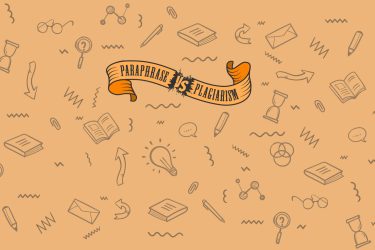It is no secret that copying someone’s work without referring to the author is wrong. This offense is called plagiarism and comes with consequences in academia, the professional and creative domains, and beyond. But how can one rely on already existing data without plagiarising? “You should paraphrase in your own words,” will come the probable answer. But then, the same instructors or editors scan for plagiarism and name “poor paraphrasing” as the main reason the paper is not unique. So, how can one evade such situations, and is there any difference between paraphrasing and plagiarising?
What is plagiarism
Plagiarism, by definition, is an act of passing off for your own the results of someone else’s work. Most often, it refers to the texts or ideas, however, this can include images, statistics, business plans, and other types of data. Plagiarism is intellectual theft, nevertheless, it can occur unintentionally, when one mistakes the information for common knowledge, gets the same ideas by coincidence, or fails to attribute the sources correctly.
Quality paraphrasing is one of the ethical ways to implement the source information without plagiarising. At the same time, poor paraphrasing, when one is retelling the text replacing the words with synonyms, and bringing no new value to the writing, can cause plagiarism.
What is paraphrasing
Paraphrasing is retelling the information in your own words. However, this notion should not be confused with synonymisation. Replacing the words with synonyms and applying some changes to the structure of the sentences is NOT paraphrasing. Moreover, even when paraphrasing, one should attribute the sources.
How to paraphrase properly
Embrace the information. First of all, collect all the data you can reach. Study it, reflect on it, and compare different points of view. Make notes, outline the bullet points, process the numbers, and draw your own conclusions. Only then, after reworking the material thoroughly, you can start your own piece. And, we assure you, if you’ve done the preparatory work properly, your text won’t resemble your source much even without additional effort!
Mind the style. We know how easy it is to get under the influence of the source of inspiration (or data.) Just ensure you don’t mimic the author of the piece you are referring to. Collecting practical information and taking a break before you proceed with actual writing may be a good approach to dividing between the source and your own text.
Add value. Your contribution is a crucial aspect that makes the difference between proper paraphrasing and plagiarism. You are creating a new piece that should bring value to the world. Relying on some existing information is good, but what is the aim of your writing? Focus on that, and spice up your work with some fresh examples, novel points of view, or even personal experience if it applies to the topic.
Reference the sources. Even the most quality paraphrasing with no direct quoting or text retelling requires proper attribution. Without that, even if you borrow only some general ideas or concepts your work will be considered plagiarism. Besides, it’s nice to provide your readers with some more useful sources to refer to!
Discover new angles. Don’t rely on a single source of information. First, it is essential to fact-check and compare different points of view. Second, it will help you to come up with your own unique piece instead of copying the one and only source of creativity. Do your research!
Check for plagiarism. Intentionally or not, your text may still resemble the source you are relying on; especially if it contains specific terms or technical data. Better be safe than sorry, hence check for plagiarism before you submit your paper, especially if it’s an important one!
Paraphrasing VS Plagiarising: the Bottom Line
Plagiarism:
- takes someone’s work and passes it off for one’s own;
- may include retelling of someone’s writing without proper reworking;
- can occur intentionally or accidentally;
- doesn’t attribute the sources.
Paraphrasing:
- uses the information from the source but reworks it;
- attributes the source correctly;
- includes the original contribution;
- differs from the source on the gist level, not only form.
PlagiarismCheck.org is here to ensure your paraphrasing is always proper, and your efforts are authentic. Try our plagiarism detector, citation generator, and AI checker GPT to access a new level of working and studying! Join us for free now.






